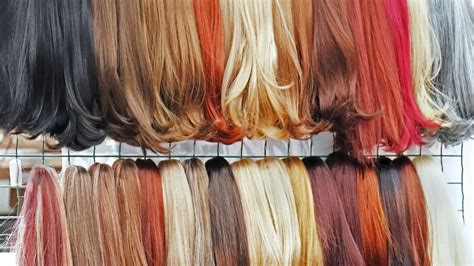A Rainbow of Colors
Wigs have become a popular and versatile accessory, allowing individuals to express their creativity and change up their appearance in an instant. With the advent of synthetic wigs, the possibilities for color customization have become virtually limitless. From vibrant hues to subtle pastels, countless shades await those who wish to transform their locks.

Statistics: According to the American Hair Loss Association, over 50% of women and 25% of men experience hair loss at some point in their lives. Wigs offer a non-surgical solution for those seeking to conceal hair loss or enhance their natural appearance.
Creative Color Combinations
1. Ombre: This popular technique involves blending two or more colors to create a gradual transition from one shade to another. Ombre wigs often feature natural hues such as brown, blonde, and black, but bold colors like green, blue, and pink can also be incorporated for a more dramatic effect.
2. Balayage: Similar to ombre, balayage involves hand-painting color onto the hair to create subtle highlights and lowlights. This technique results in a more natural-looking finish compared to traditional foil highlights.
3. Tie-Dye: This vibrant technique involves tying and dyeing the hair in different sections to create a kaleidoscope of colors. Tie-dye wigs are perfect for those who want to make a statement with their hair.
Benefits of Dyeing Synthetic Wigs
- Customization: Wigs can be dyed to match your natural hair color or create a completely new look.
- Damage Prevention: Synthetic wigs are not damaged by the dyeing process, unlike human hair.
- Cost-Effective: Dyeing a synthetic wig is significantly cheaper than getting your hair dyed professionally.
Tip: To ensure the best results when dyeing a synthetic wig, use a low-volume developer (10-20%) and test a small area before applying the dye to the entire wig.
Comparing Natural vs. Synthetic Wigs
| ** | Feature | Natural Hair | Synthetic Hair | ** |
|---|---|---|---|---|
| Texture | Soft, pliable | Smooth, shiny | ||
| Durability | Less durable | More durable | ||
| Heat Resistance | Can withstand heat up to 450°F | Can withstand heat up to 250°F | ||
| Price | Expensive | Affordable |
Strategies for Choosing the Perfect Wig Color
- Consider Your Skin Tone: Skin tone plays a major role in determining which wig colors will flatter your complexion. Warm tones suit those with yellow or golden undertones, while cool tones complement pink or blue undertones.
- Think About Your Eye Color: Blue eyes often look best with cool tones, while brown eyes are more versatile and can handle both warm and cool colors.
- Match Your Personality: Choose a wig color that reflects your personal style and mood. If you’re a bold and outgoing personality, consider a vibrant hue. If you prefer a more subtle look, opt for a natural shade.
Tips and Tricks for Dying Wigs
- Use high-quality semi-permanent dye specifically formulated for synthetic wigs.
- Immerse the wig in a large bowl of lukewarm water and dye solution for 15-30 minutes.
- Rinse the wig thoroughly with cold water until the water runs clear.
- Air dry the wig on a wig stand.
- Use a wig brush to gently style the wig once it’s dry.
Caution: Never use bleach on a synthetic wig, as it can cause irreparable damage.
Conclusion
Dyeing synthetic wigs opens up a world of creative possibilities, allowing individuals to experiment with various colors and techniques to achieve their desired look. Whether you’re looking for a subtle change or a bold transformation, a dyed wig can offer a fun and affordable way to revamp your style. Remember to choose a color that complements your skin tone and personality, and follow the tips provided to ensure a successful dyeing experience.
